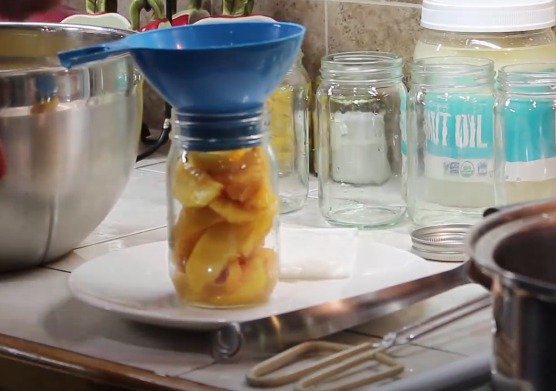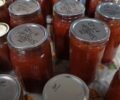How to Grow and Harvest Peaches: A Success Story from Deep South Homestead

peaches
1
Hello everybody, this is Danny from Deep South Homestead. Today, we’re diving into the rewarding process of growing and harvesting peaches. This journey with my peach tree has been filled with challenges and learning experiences, but the results are truly gratifying. Here's a comprehensive guide on how we nurtured and harvested our peaches.

2
The Creation and Care of the Peach Tree
Grafting and Growth: About twelve years ago, I grafted different peach varieties to create a unique peach tree. Despite facing challenges like borers attacking the tree, I managed to save it with some unconventional methods.

3
Dealing with Borers: An elderly lady advised me to use bleach and wood ashes to treat the borers. Later, I painted the base of the tree with diluted white latex paint and applied lime to the ground in January. These methods helped in controlling the borers and revitalizing the tree.

4
Fertilization and Blooming
Fertilization: Applying triple 13 fertilizer around the tree further boosted its health. The combination of these treatments resulted in the tree producing beautiful, large peaches.

5
Blooming Twice: Due to unusual weather patterns, the tree bloomed twice. This led to a varied size of peaches on the tree, from large ripe ones to small green ones still developing.
Harvesting and Preserving Peaches
Early Harvest: Due to the extreme temperatures and insect threats, we decided to harvest the peaches early. Despite some being slightly underripe, they were still fragrant and flavorful.

6
Canning Process: At Deep South Homestead, we believe in preserving everything. Even if it’s just a small batch, canning ensures we don't waste any produce. Here’s how we do it:
Hand Peeling: We hand peel the peaches to save the peelings for making peach jelly.
Removing Blemishes: We carefully cut out any worm-damaged sections, ensuring the rest of the peach is perfect for canning.
Lemon Water Bath: To prevent browning, we soak the peeled peaches in lemon water.
Cutting and Prepping: We cut the peaches into pieces for easy use in recipes like peach pies.
Making Light Syrup
Preparing the Syrup: We use an extra light syrup to preserve the natural flavor of the peaches. The ratio is one cup of sugar to five cups of water.
Filling the Jars: We pack the peaches into jars and fill them with the light syrup, leaving some headspace.
Water Bath Canning
Canning Jars: We use recycled jars, perfect for water bath canning.
Processing: After filling the jars, we water bath can them for 25 minutes, ensuring a proper seal and long-lasting preservation.
Final Results and Tips
Beautiful Peaches: The end result is six jars of delicious, homegrown peaches.
Canning Tips:
Use Sharp Knives: A sharp knife is essential for hand peeling and cutting peaches.

7
Prevent Oxidation: Always use lemon water or citric acid to keep peaches from browning.
Conclusion
Growing and harvesting peaches at Deep South Homestead has been a journey of patience, learning, and adaptation. With the right care and preservation techniques, you can enjoy the fruits of your labor all year round. Remember, preserving your harvest not only prevents waste but also ensures you have delicious, homegrown produce regardless of external conditions.
Happy canning!

Ingredients
peaches
Directions
1
Hello everybody, this is Danny from Deep South Homestead. Today, we’re diving into the rewarding process of growing and harvesting peaches. This journey with my peach tree has been filled with challenges and learning experiences, but the results are truly gratifying. Here's a comprehensive guide on how we nurtured and harvested our peaches.

2
The Creation and Care of the Peach Tree
Grafting and Growth: About twelve years ago, I grafted different peach varieties to create a unique peach tree. Despite facing challenges like borers attacking the tree, I managed to save it with some unconventional methods.

3
Dealing with Borers: An elderly lady advised me to use bleach and wood ashes to treat the borers. Later, I painted the base of the tree with diluted white latex paint and applied lime to the ground in January. These methods helped in controlling the borers and revitalizing the tree.

4
Fertilization and Blooming
Fertilization: Applying triple 13 fertilizer around the tree further boosted its health. The combination of these treatments resulted in the tree producing beautiful, large peaches.

5
Blooming Twice: Due to unusual weather patterns, the tree bloomed twice. This led to a varied size of peaches on the tree, from large ripe ones to small green ones still developing.
Harvesting and Preserving Peaches
Early Harvest: Due to the extreme temperatures and insect threats, we decided to harvest the peaches early. Despite some being slightly underripe, they were still fragrant and flavorful.

6
Canning Process: At Deep South Homestead, we believe in preserving everything. Even if it’s just a small batch, canning ensures we don't waste any produce. Here’s how we do it:
Hand Peeling: We hand peel the peaches to save the peelings for making peach jelly.
Removing Blemishes: We carefully cut out any worm-damaged sections, ensuring the rest of the peach is perfect for canning.
Lemon Water Bath: To prevent browning, we soak the peeled peaches in lemon water.
Cutting and Prepping: We cut the peaches into pieces for easy use in recipes like peach pies.
Making Light Syrup
Preparing the Syrup: We use an extra light syrup to preserve the natural flavor of the peaches. The ratio is one cup of sugar to five cups of water.
Filling the Jars: We pack the peaches into jars and fill them with the light syrup, leaving some headspace.
Water Bath Canning
Canning Jars: We use recycled jars, perfect for water bath canning.
Processing: After filling the jars, we water bath can them for 25 minutes, ensuring a proper seal and long-lasting preservation.
Final Results and Tips
Beautiful Peaches: The end result is six jars of delicious, homegrown peaches.
Canning Tips:
Use Sharp Knives: A sharp knife is essential for hand peeling and cutting peaches.

7
Prevent Oxidation: Always use lemon water or citric acid to keep peaches from browning.
Conclusion
Growing and harvesting peaches at Deep South Homestead has been a journey of patience, learning, and adaptation. With the right care and preservation techniques, you can enjoy the fruits of your labor all year round. Remember, preserving your harvest not only prevents waste but also ensures you have delicious, homegrown produce regardless of external conditions.
Happy canning!

Leave a Review
Please log in or register for a new account in order to leave a review.










